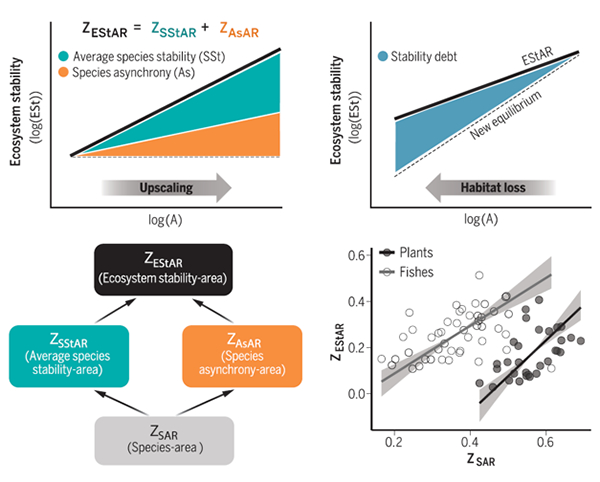Supported by the National Natural Science Foundation of China (Grant Nos. 31988102, 32425036), an international research team led by Prof. Wang Shaopeng from the Institute of Ecology, College of Urban and Environmental Sciences, Peking University, has achieved new theoretical advances by elucidating the link between spatial scaling patterns of biodiversity and ecosystem stability. This research, titled “Unifying spatial scaling laws of biodiversity and ecosystem stability” was published in Science on March 21, 2025 (https://www.science.org/doi/10.1126/science.adl2373).

Figure. Spatial scaling of ecosystem stability and its associations with the scaling of biodiversity
Ecological stability characterizes an ecosystem's ability to maintain its structure and function in response to environmental change. In the face of global change, maintaining ecosystem stability is fundamental to the sustainable development of both natural communities and human society. Since the 1990s, numerous studies have demonstrated that biodiversity is a key factor in maintaining ecosystem stability. However, these findings derive largely from studies with small spatial scales. Whether these findings can be extended to larger scales and what mechanisms underlie their scaling patterns remain unresolved questions.
The research team developed a novel theoretical framework that decomposes the scaling of ecosystem stability (i.e., the ecosystem stability-area relationship) into two components: the scaling of species stability (i.e., the species stability-area relationship) and the scaling of species asynchrony (i.e., the species asynchrony-area relationship). Using this framework, the team used community dynamics models and showed that both species stability and ecosystem stability increase with increasing spatial scale (i.e., area), while species asynchrony may either increase or decrease. As the study area increases, a faster increase in species diversity could trigger a faster increase in ecosystem stability. This theoretical prediction was supported by regional-scale data from plant and fish communities.
By clarifying the link between scaling patterns of biodiversity and stability, this study not only extends the traditional biodiversity-stability theory to a multi-scale context but also provides new insights into the ecological consequences of habitat loss. Models predict that habitat destruction reduces both species diversity and ecosystem stability, but with a delayed effect. Following habitat loss, species extinction does not occur immediately but instead unfolds gradually over time—a phenomenon known as “extinction debt”. This extinction debt in turn leads to a “stability debt”, whereby ecosystem stability declines gradually over a prolonged period following habitat loss. These findings provide new insights for biodiversity conservation and ecosystem management.

Add: 83 Shuangqing Rd., Haidian District, Beijing, China
Postcode: 100085
Tel: 86-10-62327001
Fax: 86-10-62327004
E-mail: bic@turningpointcsc.org
京ICP备05002826号 文保网安备1101080035号 Copyright 2017 NSFC, All Right Reserved